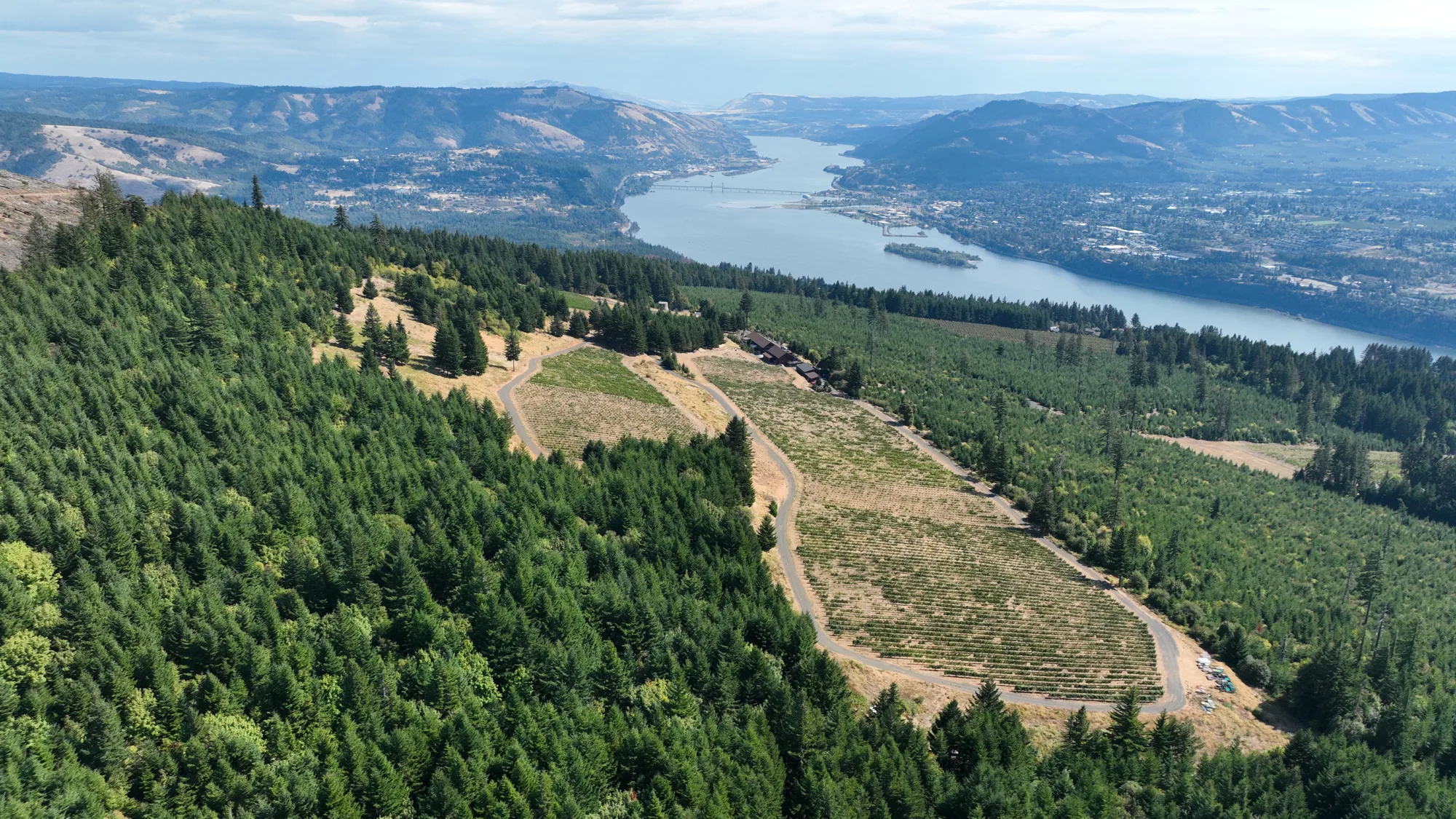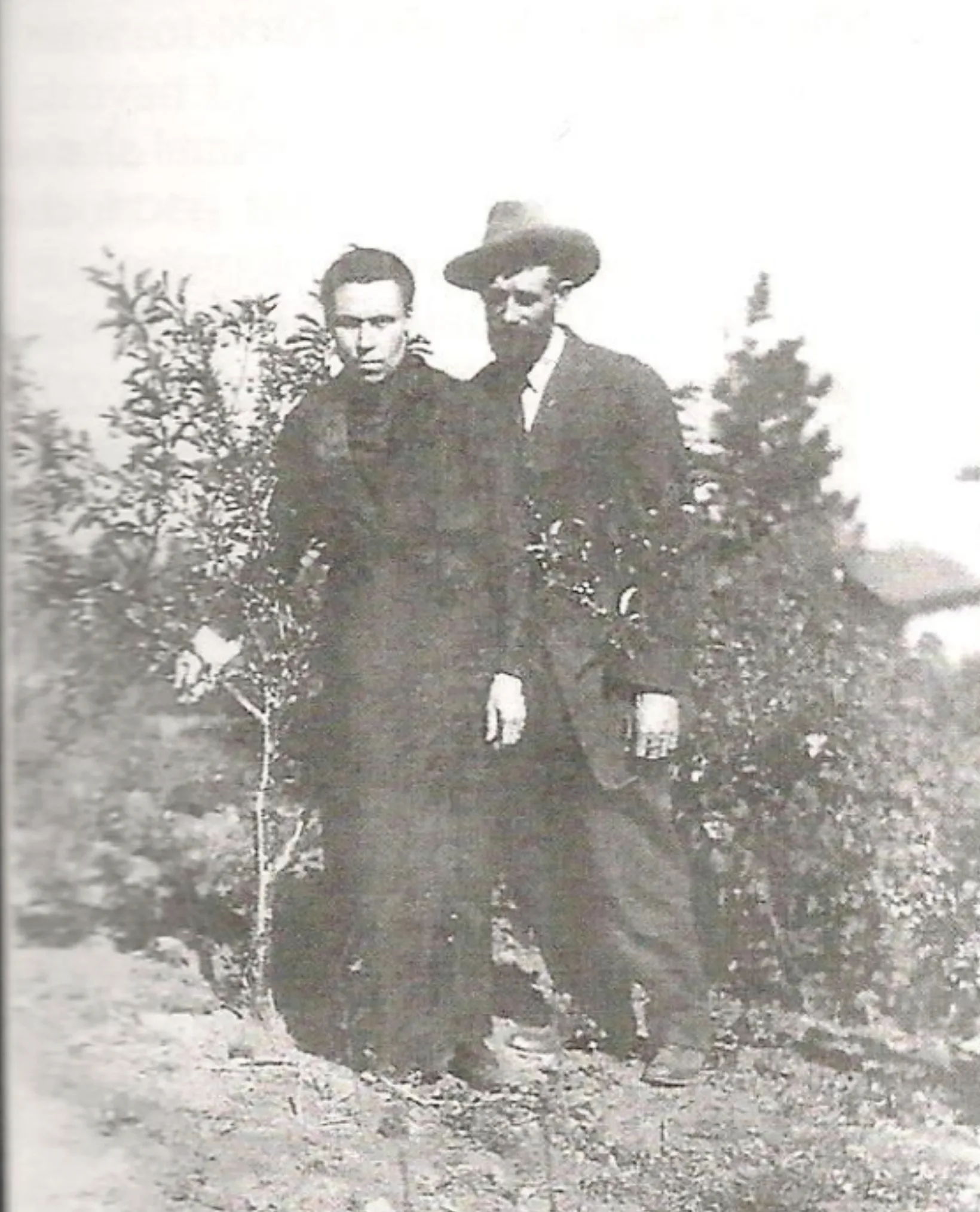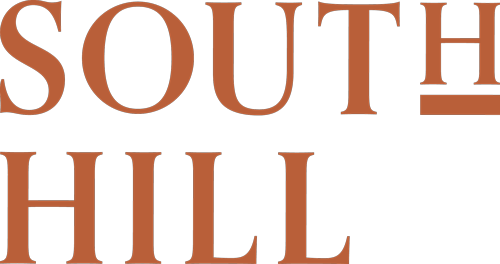History and Grapegrowing on Washington’s Underwood Mountain

View of South Hill Winery and Vineyards on Underwood Mountain, looking east towards Hood River in 2023
History & Winegrowing on Washington’s Underwood Mountain
Underwood Mountain, across the Columbia from Hood River, has been used for logging, growing apples and pears, and most recently wine grape growing. This article takes a look at the progression of Underwood Mountain from remote wilderness to the acclaimed winegrowing region that it is today (and home to several popular wineries, including South Hill Vineyards.)
Where is Underwood Mountain, and what created it?
Underwood is an unincorporated community in Skamania County, Washington, nestled on the side of Underwood Mountain, which rises to 2,755 feet. The area benefits from excellent soil and climate conditions, supporting premium vineyards and thriving organic farms.
Geologically, Underwood Mountain is an early Pleistocene shield volcano that erupted between 20,000 and 850,000 years ago, covering east-dipping Grande Ronde Basalt. The mountain’s basalt comprises numerous blocky, jointed flows, each about 10 to 30 feet thick, reaching a total thickness of at least 590 feet. These lavas once crossed and probably briefly dammed the Columbia River, with remnants of the flows found on the Oregon side.
Read More about the Geology in the book Underwood Through The Years (PDF)
Where does the name Underwood come from?
The name Underwood comes from early settler Amos Underwood and his brother Ed. Amos acquired land near the mouth of the White Salmon River using his personal military land bounty for a free homestead on railroad land claims along the north shore. He also bought a settler’s homestead, so that his land totaled 320 acres. In 1861 Amos operated a ferry from his homestead to Hood River. He owned two freight scows, a saloon and 10 gold mines near Mt. Adams. Ed Underwood, younger brother of Amos, came to the area in 1865 and filed for a homestead on the bluff above the Columbia River.
Given the geology and steep terrain of the mountain, historically what was the land used for economically?
“Logging was the first widespread industry, and this cleared the land. Then Apple growing, same as in White Salmon and Hood River until the freeze of 1918-19. Pears were replanted as they are more cold-resistant. Underwood had the advantage of not requiring irrigation due to its deep soils and its moisture retention. That was great for many years but eventually over the past 30 years, irrigated orchards proved to be more reliable and economically more profitable. In general, wells are not viable on Underwood as most of the deep ground water is locked up in volcanic lava tubs. Other than a few springs most of the water is now obtained by the PUD, pumped back up the mountain from where springs pop out near the river.” – Phil Jones, Owner South Hill Vineyards
When clearing the land for South Hill Vineyard, owner Phil Jones came across the remnants of a previous homestead. What did you find and what does it tell you about the people who lived on this land before you?
“The lower 1/2 of our home acreage with the winery was in pear orchard from the 1920s through the 1960s. The orchard was abandoned at that point, most likely to old age and reducing yields. It was not replanted. The foundation at the drive entry of South Hill Vineyards was either an old house or shed. On the forestry block above our property there were foundations of an old homestead owned by the Collins family. They planted an apple orchard up there when it was homesteaded about 1918. The daughter purchased the current winery 80 acres in the 1920s. They raised a family but in the early 1930s lost the upper property and it was bought by a lumber company for forestry. The daughter sold our 80 acres, and it was planted partially to pears. A lot of upper Underwood was cleared and planted to orchards but most of the higher elevations and most of the east side of the mountain proved unsuitable for fruit as it was that much colder.” – Phil Jones, Owner South Hill Vineyards
The primary economic/agricultural industry on the mountain is now grape growing. What makes the mountain so ideal for growing grapes?
“Wine grapes are more drought resistant than pears (the previous favored crop un Underwood), but one or two irrigations in dry summers can be beneficial. South Hill Vineyards gets our water from the PUD so it is expensive and only 1-2 irrigations are feasible. The south facing slopes provide perfect sunshine for growth. The winds prevent many grape diseases from causing problems, requiring less sprays. We do not have insect problems either. Our biggest problem are Gophers which thrive in these conditions and will even kill or severely damage mature vines. We bait every year and have them under pretty good control.” – Phil Jones, Owner South Hill Vineyards

Harriet and George Collins, early settlers of Underwood Mountain
Underwood Newspaper Articles From The Past
-
from Apr. 1856 – Cascade City Taken by the Indians! (posted December 2007)
-
from Dec. 1890 – Indian War Reminiscences (posted July 2006)
-
from Sept. 1894 – Across the Columbia (posted September 2007)
-
from Dec. 1894 – The Old Block House at the Cascades (posted March 2007)
-
from May 1895 – A Pioneer (posted September 2007)
- from Jan./Feb. 1897 – Reminiscences of the Cayuse War (posted July 2006)
- from Jul. 1897 – Mines of Skamania (posted July 2011)
- from 1901 – Murder In The First Degree (posted April 2008)
- from Jan. 1905 – Underwood to Build New Dock (posted July 2006)
- from Jul. 1905 – Famed As An Indian Fighter (posted May 2003)
- from Jan. 1907 – Want Station at Underwood (posted September 2007)
- from May 1907 – Buy At Underwood (posted September 2007)
- from Aug. 1907 – Three Columbia River Towns (posted December 2008)
- from Sep. 1907 – Uncle Amos Underwood Goes East (posted April 2008)
- from Jan. 1908 – The Cayuse War (posted May 2003)
- from Apr. 1908 – A Trip to Underwood (posted July 2006)
- from May 1908 – Underwood Needs Railroad Station (posted September 2007)
- from Jun. 1908 – Underwood is Growing Fast (posted July 2006)
- from Apr. 1909 – Underwood Improvement Club (posted July 2006)
- from Nov. 1909 – Underwood (posted September 2007)
- from Nov. 1909 – Underwood (posted July 2006)
- from Jul. 1910 – Indian Fights Of Early Days In Pacific Northwest Are Recalled (posted May 2003)
- from Dec. 1910 – Some Facts About Stevenson (posted December 2009)
- from Dec. 1910 – Progress (posted December 2009)
- from Jun. 1911 – Collins Hot Springs Is Popular Resort (posted June 2011)
- from Aug. 1911 – Underwood View (posted May 2007)
- from Mar. 1911 – Put New Boat On Underwood Ferry (posted April 2008)
- from Jul. 1913 – Underwood District Grows (posted September 2007)
- from Jul. 1913 – Many Attractive Underwood Homes (posted September 2007)
- from Oct. 1913 – Orchards Thrive in Skamania County (posted December 2008)
- from Jul. 1915 – Underwood District Is Rival Of Bar Le Duc (posted April 2008)
- from Jan. 1918 – Indian Days Recalled (posted May 2003)
- from Jan./Feb./Jul./Aug 1918 – Story of The Cayuse War – (posted November 2004)
- from Oct. 1922 – Propose Railroad for Underwood (posted September 2007)
- from Oct. 1922 Goose Lake Region Scenic Storehouse (posted June 2011)
- from Jan. 1923 – Underwood Prepares for Coming Boom (posted July 2006)
- from Oct. 1924 – $75,000 Fire Loss At Underwood (posted April 2008)
- from Jun. 1925 – Underwood Grows as a Shipping Center (posted November 2005)
- from Aug. 1925 – New Fruit Plant At Underwood (posted April 2008)
- from Jan. 1926 – Much Prosperity Seen At Underwood During 1925 (posted April 2008)
- from Jun. 1926 – Underwood Big Shipping Point (posted April 2008)
- from Aug. 1926 – $18,000 Addition At Underwood (posted April 2008)
- from Jan. 1927 – Memories of my Childhood (posted November 2007)
- from Jan. 1927 – My Arrival in Washington in 1852 (posted November 2007)
- from Jan. 1927 – Early Days at the Cascades (posted November 2007)
- from Jan. 1927 – Underwood Store bought by Cascade Locks Men (posted September 2007)
- from Jan. 1928 – The Indian Raid of the Cascades in March, 1856 (posted November 2007)
- from Feb. 1931 – Underwood Gymnasium Completed (posted April 2008)
- from Jul. 1931 – Underwood Fruit & Warehouse Co. Increases Cold Storage (posted April 2008)
- from Nov. 1931 – When the Yakimas Went Berserk (posted March 2007)
- from Aug. 1935 – An Interview with Mrs. Edward Underwood, by Fred Lockley (posted September 2007)
- from Jan. 1934 – The Slaying of Pio-Pio-Mox-Mox (posted November 2007)
- from Jan. 1937 – Incidents in Sailing Columbia River are Related by Pioneer (posted September 2007)
- from Jan. 1937 – Pioneer Recalls Early Carson and Hardships of 50 Years Ago (posted September 2007)
- from May 1937 – Society Sees Big Collection of Rosaries (posted September 2007)
- from May 1938 – Mary V. Lane Tells of Times Before Autos and Radios (posted April 2005)
- from Apr. 1939 – “History of Settlement of the Wind River Valley” (posted September 2007)
- from Jun. 1939 – Underwood Heights Drive Reveals Scenic Beauty (posted December 2008)
- from Jan. 1941 – Pioneer Writes of Life in County 50 Years Ago (posted December 2008)
- from Dec. 1943 – How Skamania County Looked 60 Years Ago (posted December 2008)
- from Nov. 1945 – Homesteader of 1903 Prominent in Development ……. (posted May 2003)
- from May 1946 – Fires Take Toll In Area Over Past Week End (posted April 2008)
- from May 1946 – Underwood Razed by Fire Last Sunday (posted July 2006)
- from May 1946 – This Is How A Story Can Spread (posted April 2008)
- from Feb. 1948 – Underwood Grower Wins In Battle With …. (posted July 2006)
- from May 1951 – Chenowith Pioneers Recall Story About First Loggers (posted December 2008)
- from Oct. 1951 – Weather Rock Rediscovered At Underwood (posted May 2003)
- from Mar. 1955 – Magazine Lauds Underwood Man (posted May 2003)
- from Jun. 1955 – Monster Flames Engulf Big Underwood Plant (posted September 2007)
- from May 1964 – Balsigers To Close Store At Underwood (posted April 2008)
- from Jun. 1964 – Underwood Store Sold (posted April 2008)
- from Summer 1996 – Hatcheries Fete 100 Years (posted September 2007)
- from Sep. 2001 – Hatchery Celebrates 100 years (posted July 2006)
- Underwood Family Letters (posted May 2003)
